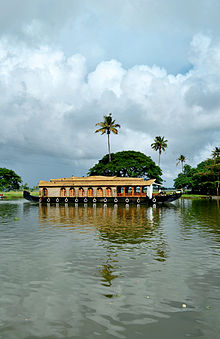Kerala, a state situated on the tropical Malabar Coast of southwestern India, is one of the most popular tourist destinations in the country. Named as one of the ten paradises of the world by National Geographic Traveler,[1] Kerala is famous especially for its ecotourism initiatives and beautiful backwaters.[2] Its uniqueculture and traditions, coupled with its varied demography, have made Kerala one of the most popular tourist destinations in the world. Growing at a rate of 13.31%, the tourism industry is a major contributor to the state's economy.[3]
Until the early 1980s, Kerala was a relatively unknown destination, with most tourism circuits concentrated around the north of the country. Aggressive marketing campaigns launched by the Kerala Tourism Development Corporation—the government agency that oversees tourism prospects of the state—laid the foundation for the growth of the tourism industry. In the decades that followed, Kerala Tourism was able to transform itself into one of the niche holiday destinations in India. The tag line Kerala – God's Own Country was adopted in its tourism promotions and became a global superbrand. Kerala is regarded as one of the destinations with the highest brand recall.[4] In 2010, Kerala attracted 660,000 foreign tourist arrivals.[5]
Kerala is an established destination for both domestic as well as foreign tourists. Kerala is well known for its beaches, backwaters in Alappuzha andKollam, mountain ranges and wildlife sanctuaries. Other popular attractions in the state include the beaches atKovalam, Kappad, Cherai and Varkala; backwater tourism and lake resorts around Ashtamudi Lake, Kollam; hill stations and resorts at Munnar,Wayanad, Nelliampathi, Vagamon andPonmudi; and national parks and wildlife sanctuaries at Periyar and Eravikulam National Park. The "backwaters" region—an extensive network of interlocking rivers, lakes, and canals that centre onAshtamudi Lake, Kollam, also see heavy tourist traffic. Heritage sites, such as thePadmanabhapuram Palace, Hill Palace, and Mattancherry Palace, are also visited. The city of Trivandrum ranks first in the total number of international and domestic tourists in Kerala.[6][7] To further promote tourism in Kerala, theGrand Kerala Shopping Festival was started by the Government of Kerala in 2007.[8] Since then it has been held every year during the December–January period.
The state's tourism agenda promotesecologically sustained tourism, which focuses on the local culture, wilderness adventures, volunteering and personal growth of the local population. Efforts are taken to minimise the adverse effects of traditional tourism on the natural environment, and enhance the cultural integrity of local people.
Historical context
Since its incorporation as a state, Kerala's economy largely operated underwelfare-based democratic socialistprinciples. This mode of development, though it resulted in a high Human Development Index and standard of living among the people, led to aneconomic stagnation in the 1980s (growth rate of 2.3% annually).[9]) This apparent paradox—high human development and low economic development—led to a large number of educated unemployed seeking jobs overseas, especially in the Gulf countries. Due to the large number of expatriates, many travel operators and agencies set up shop in the state to facilitate their travel needs. However, the trends soon reciprocated, with the travel agencies noticing the undermined potential of the state as a tourist destination. The first travel agency in Kerala, Kerala Travels, was founded by Col G.V. Raja of the Travancore royal family along with P.G.C. Pillai.
By 1986, tourism had gained an industry status. Kerala Tourism subsequently adopted the tagline God's Own Country in its advertisement campaigns. Aggressive promotion in print and electronic media were able to invite a sizable investment in the hospitality industry. By the early 2000s, tourism had grown into a full–fledged, multi-billion dollar industry in the state. The state was able to carve a niche for itself in the world tourism industry, thus becoming one of the places with the "highest brand recall".[10] In 2003, Kerala, a hitherto unknown tourism destination, became the fastest growing tourism destination in the world.[11]





No comments:
Post a Comment